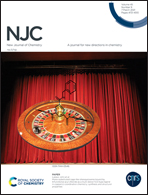Novel dual acceptor (D–D′–A′–π–A) dye-sensitized solar cells based on the triarylamine structure and benzothiadiazole double electron withdrawing unit†
Abstract
Three novel D–D′–A′–π–A type organic dyes (BT4, BT5 and BT6) based on aniline derivatives (containing fluorene, carbazole and phenothiazine segments as D′) and formic acid as anchoring groups have been synthesized for dye-sensitized solar cells (DSCs). To fine-tune absorption spectra, energy levels, and photovoltaic properties of these dyes, an auxiliary electron-withdrawing benzothiadiazole (BT) unit was introduced into their backbones. It was found that dye BT5 with a carbazole containing triarylamine as the electron-donating unit exhibits a broader absorption profile, higher molar extinction coefficient and better photovoltaic performance than those of BT4 and BT6. The power conversion efficiency (PCE) of the BT5-based DSC was up to 3.61%. This implied that the incorporation of the BT unit can cause a pronounced electron transfer effect with triarylamine segments, and therefore affect the absorption bands, Stokes shifts and PCE of DSCs.



 Please wait while we load your content...
Please wait while we load your content...